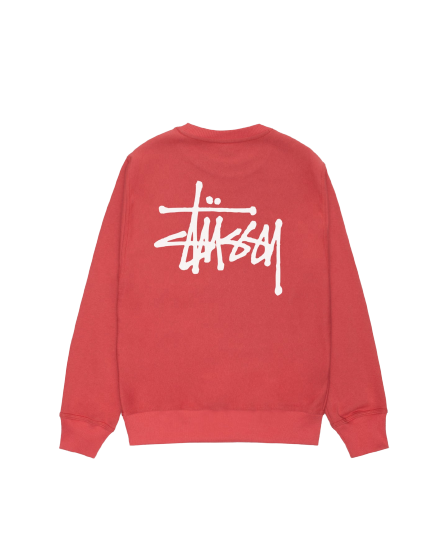The Birth of a Cultural Phenomenon
Few fashion brands have managed to transcend their humble beginnings and reshape the way entire generations dress. Stüssy is one of those rare names. More than just a label, Stussy is a cultural icon that has left an indelible mark on streetwear, music, and global youth culture. What began as a surfboard shaper’s signature in California has now become one of the most recognized streetwear brands in the world, standing shoulder to shoulder with luxury fashion houses and influencing designers far beyond the subculture that birthed it.
The brand’s success lies in its ability to blend authenticity with adaptability. From surf culture to hip-hop, from punk to skateboarding, Stüssy has consistently found itself at the heart of movements that defined urban life for decades. To understand the legacy of Stüssy is to understand the evolution of streetwear itself.
The Origins: From Surfboards to Streetwear
The story of Stüssy begins in the early 1980s with Shawn Stüssy, a surfboard shaper from Laguna Beach, California. Shawn wasn’t aiming to become a fashion mogul. His initial vision was simple: create high-quality surfboards for a community that lived and breathed ocean waves. On each of his boards, he scrawled his surname in a graffiti-like handstyle signature, a mark that would later evolve into one of the most iconic logos in fashion.
To promote his surfboards, Shawn began screen-printing T-shirts, caps, and shorts with the same handwritten signature. The shirts quickly caught on—not just among surfers, but also with skaters, musicians, and young people across California who were drawn to their raw, rebellious aesthetic. Unlike mainstream surf brands of the time, Stüssy felt less corporate and more authentic, carrying the spirit of underground culture in every piece.
By 1984, Shawn Stüssy partnered with Frank Sinatra Jr. (no relation to the legendary singer) to formalize the business. Together, they laid the foundation of what would become one of the most influential fashion brands of the 20th century.
The Power of the Stüssy Logo
The handwritten Stussy logo became more than a brand marker—it became a symbol of identity. Its graffiti-inspired design mirrored the visual language of street culture that was simultaneously emerging in cities across America. Young people in Los Angeles, New York, and London were beginning to carve out new creative expressions in music, art, and style, and the Stüssy logo fit right into that rebellion against the mainstream.
Over time, Stüssy introduced additional motifs, like the Stüssy “S” (often mistakenly thought to be unrelated to the brand) and the “World Tour” graphics that listed global cities alongside major cultural hubs of hip-hop and punk. These graphics suggested that Stüssy wasn’t just a surf label—it was an international movement, uniting subcultures across continents.
The 1980s: Stüssy as a Lifestyle Movement
What made Stüssy unique in the 1980s was its positioning. While most surf brands focused solely on coastal lifestyles, Stüssy embraced the fusion of multiple subcultures. Its clothing was worn by skaters bombing hills in Southern California, DJs spinning records in New York, and punks tearing up clubs in London.
The brand didn’t rely on traditional advertising campaigns. Instead, it thrived through word of mouth, underground marketing, and community building. Exclusive drops, limited-edition pieces, and collaborations with artists made the clothing feel special. Stüssy stores became cultural hubs, where young people could connect, share ideas, and embrace a shared identity rooted in creativity and rebellion.
By the late 1980s, Stüssy had become synonymous with what would later be called “streetwear.” It wasn’t just clothing—it was a badge of belonging.
The Stüssy Tribe: Building a Community Around Style
One of Stussy Hoodie most brilliant moves was the creation of the “International Stüssy Tribe.” This wasn’t just a marketing campaign; it was a collective of like-minded creatives, DJs, skaters, and musicians who embodied the spirit of the brand. Members of the tribe included influential figures like Hiroshi Fujiwara in Japan, Alex Turnbull in the UK, and James Jebbia—who would later go on to found Supreme.
The Tribe connected people across continents, establishing Stüssy as a truly global movement well before the internet made such connections commonplace. The brand’s World Tour T-shirts, which listed cities like Tokyo, London, and New York alongside cultural capitals like Los Angeles, symbolized this international reach. Wearing Stüssy meant being part of something bigger than fashion—it was belonging to a worldwide network of creative rebels.
The 1990s: Streetwear Meets High Fashion
By the 1990s, Stüssy had cemented its role as a pioneer of streetwear. What set the brand apart during this era was its ability to exist comfortably in both underground and mainstream spaces. Hip-hop artists, skateboarders, and ravers all wore Stüssy, but so did trendsetters in fashion capitals like Paris and Milan.
The 1990s also marked a period of experimentation. Stüssy began collaborating with other designers and artists, introducing limited-edition pieces that blurred the line between streetwear and high fashion. This approach, which is now common in the industry, was revolutionary at the time. The brand’s emphasis on exclusivity, rarity, and cultural cachet set the tone for how modern streetwear operates today.
Shawn Stüssy eventually stepped away from the company in 1996, leaving behind a legacy that would continue to grow even without his direct involvement. The brand entered a new era, adapting to shifting trends while maintaining its authentic identity.
The Evolution in the 2000s: Staying Relevant in a Changing World
The early 2000s were a challenging time for many streetwear brands. Trends shifted rapidly, and newer labels like Supreme began to dominate youth culture. Yet, Stüssy managed to remain relevant by staying true to its roots while embracing collaborations and international growth.
In Japan, Stüssy became a powerhouse, thanks in large part to the influence of Hiroshi Fujiwara and the deep connection between Japanese streetwear and global fashion. Stüssy stores in Tokyo and other cities became destinations for fashion enthusiasts, bridging the gap between Western and Eastern street culture.
Meanwhile, collaborations with brands like Nike, Levi’s, and Dior kept Stüssy fresh and appealing to new generations. The brand’s willingness to experiment without losing its core identity is what allowed it to endure when many of its contemporaries faded away.
The 2010s: The Streetwear Explosion
The 2010s marked a renaissance for Stüssy as streetwear exploded into mainstream fashion. What was once considered niche or subcultural became the defining aesthetic of the decade. Luxury brands like Louis Vuitton, Gucci, and Balenciaga began embracing streetwear silhouettes, often collaborating directly with streetwear labels.
In this environment, Stüssy thrived. The brand’s archive of designs, its legendary logo, and its history as a pioneer gave it credibility that newer labels could only dream of. Collaborations with Nike on Air Force 1s, with Converse on Chuck Taylors, and with high-fashion designers reaffirmed Stüssy’s place at the center of the streetwear movement.
Moreover, the rise of social media and resale culture gave Stüssy a new platform. Limited drops sold out instantly, with pieces fetching high prices on the secondary market. The brand’s ability to stay relevant over decades became a testament to its adaptability and cultural weight.
Stüssy in the 2020s: Legacy Meets Innovation
Today, Stussy Clothing is more influential than ever. The brand continues to release collections that honor its history while pushing into new creative territories. Its collaborations remain highly anticipated, and its seasonal drops consistently generate excitement in both streetwear and fashion circles.
What makes Stüssy particularly remarkable in the 2020s is its multigenerational appeal. For older fans, it represents nostalgia and authenticity; for younger fans, it’s a badge of cultural relevance. The brand has achieved the rare feat of staying fresh without betraying its roots.
The Design Philosophy: Simplicity with Meaning
At the heart of Stüssy’s enduring success is its design philosophy. The clothing is often simple—graphic tees, hoodies, hats, and workwear-inspired pieces—but each item carries cultural weight. The handwritten logo, the crown graphic, the double S symbol, and the World Tour print are all instantly recognizable.
This simplicity is intentional. Stüssy doesn’t overcomplicate its designs because the power lies in what they represent: rebellion, creativity, community, and authenticity. Unlike trend-driven fast fashion, Stüssy has always designed for longevity, which is why its vintage pieces remain highly sought after decades after their release.
The Impact of Collaborations
Collaborations have been central to Stüssy’s strategy for decades. From Nike to Carhartt, from Levi’s to Dior, Stüssy has partnered with brands across industries, each time adding a new dimension to its identity. These collaborations are not just about hype; they’re about cultural storytelling.
For example, the Stüssy x Nike collaborations reflect the intersection of sportswear and street culture. The Stüssy x Dior capsule, meanwhile, represents the brand’s seamless ability to merge with high fashion. Each collaboration feels authentic, because Stüssy has never forced itself into partnerships—it only works with brands that align with its ethos.
Stüssy and Sustainability: Looking Forward
As the fashion industry faces increasing pressure to address sustainability, Stüssy has also begun adapting. While it doesn’t market itself as an eco-conscious brand, there has been a noticeable shift toward better production practices, higher quality fabrics, and timeless designs that encourage long-term use. In many ways, Stüssy’s philosophy of creating clothes meant to last already aligns with the push for a more sustainable fashion future.
Cultural Legacy: More Than Just a Brand
Stüssy’s true legacy lies not just in its clothing, but in its role as a cultural connector. It has brought together people from diverse backgrounds—surfers, skaters, rappers, DJs, and fashion enthusiasts—and given them a shared identity. It has inspired countless other brands, from Supreme to Palace, and helped define what we now recognize as streetwear.
The International Stüssy Tribe, the World Tour graphics, and the iconic logo are more than design elements—they are cultural artifacts. They remind us that fashion can be more than commerce; it can be a language, a community, and a movement.
Stüssy’s Timeless Influence
Stüssy is not just another clothing brand—it is the blueprint for streetwear. From Shawn Stüssy’s surfboards in Laguna Beach to collaborations with global fashion houses, the brand has traveled an extraordinary journey. It has remained authentic while adapting to changing times, proving that true cultural relevance doesn’t fade—it evolves.
As we look to the future of fashion, one thing is clear: Stüssy will continue to influence, inspire, and unite. It is more than clothing—it is a movement that has shaped generations and will keep shaping the cultural landscape for decades to come.


